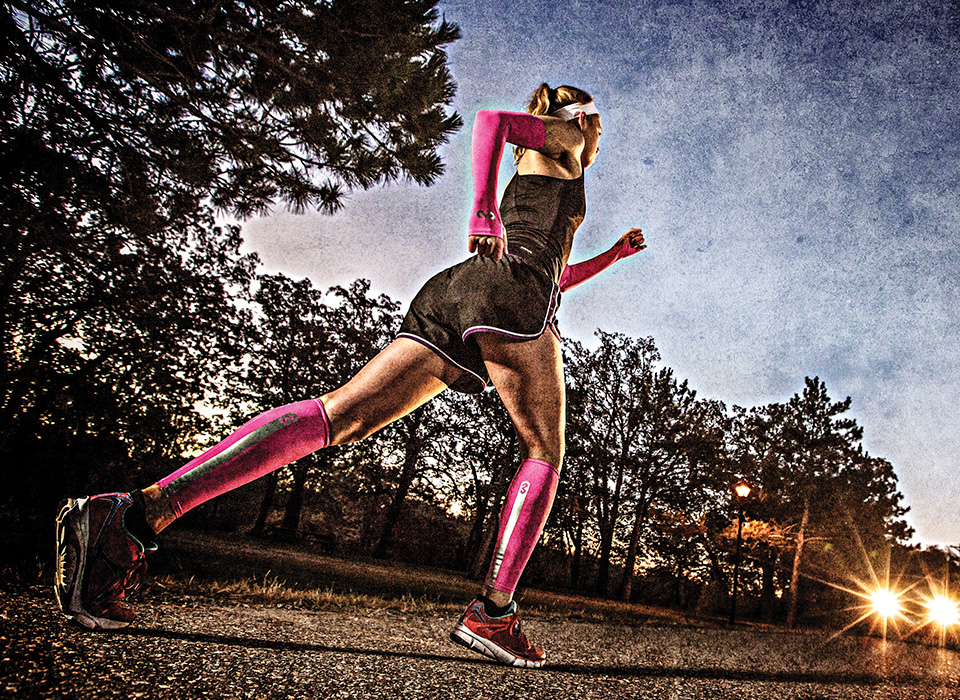The Skinny on Compression Wear

You’ve more than likely seen it down on the trail or skirting around at the gym. It’s been modeled and endorsed by celebrities and pro athletes in fitness magazines and infomercials. A growing segment of the athletic apparel industry, compression wear is sold as socks, shorts, shirts, tights, sleeves, and tri-suits. Made of colorful, high-tech fabrics, their claimed benefits run the gamut from improved power and endurance performance to speedier and less painful recovery. Curious if these claims had any merit, we dug into the research and talked to scientists, athletes, and vendors. What was their consensus on compression wear? Here’s what we discovered.
Background
Tan-colored (and fairly unflattering) compression hose have been used effectively in clinical settings for the past 50 years or so. Research and experience have shown compression hose aid in the return of venous blood from the legs to the heart and lungs of patients confined to hospital beds or wheelchairs. This practice helps prevent blood from pooling and clotting—which can lead to all kinds of complications and even death. Other benefits include promotion of lymphatic circulation, joint stabilization after surgical repair, rehab, and wound care.
Somewhere along the way, an enterprising trainer, physical therapist, or marketing executive thought that athletes might benefit from improved blood flow as well, and a new product line was born.
Technology
Socks were the first compression products adapted for performance purposes; they are the most common items in use by athletes today. They function by way of a progressively tighter weave in the fabric that makes them snug at the top of the calf, a bit tighter at mid-calf, and even tighter at the ankle. This provides greater positive pressure from the bottom up, which works with the natural skeletal muscle pump of the lower leg muscles to return de-oxygenated (venous) blood back up to the heart and lungs.
Performance Claims
A quick survey of the sport science literature turned up considerable research supporting the likelihood of compression wear benefits for athletes in endurance, strength, and power sports, though there are some studies showing no significant effect.
Professor Aaron Coutts of the University of Technology, Sydney and an Associate Editor of the International Journal of Sports Physiology and Performance, wrote the following in an article:
“It appears the use of compression garments may have a positive effect on athletes during exercise and during recovery periods following exercise. As no studies have reported negative effects on exercise performance or perceptions of pain, the use of compression garments may provide a useful training tool for athletes across a wide variety of sports.”
Coutts continues with an impressive list of potential benefits backed up by science. Here are a few, with the type of athletes likely to see the greatest benefits included in parentheses.
-
Enhancing blood circulation to peripheral limbs (everyone)
-
Reducing blood lactate concentration during maximal exercise bouts (runners, cyclists, rowers, sprinters)
-
Enhancing warm-up via increases in skin temperature (everyone)
-
Increasing vertical jump height and improving repetitive jump power (field and court sport athletes, strength and power athletes)
-
Enhancing recovery following strenuous exercise by aiding in the removal of blood lactate and improving subsequent exercise performance (everyone)
-
Reducing the effects of delayed onset muscle soreness in the days following strenuous exercise (strength athletes, runners)
Chuck Duvall, performance apparel guru at Austin Tri-Cyclist, has had personal experience with wearing compression gear, and has conducted his own research on companies like 2XU, 110%, and Under Armour that produce the products. “I believe the primary benefit [of compression wear] for endurance athletes lies in the area of recovery more so than in performance,” Duvall said.
Carey Kepler, four-time international Crossfit Games competitor and co-owner of Crossfit Central, uses the SKINS brand calf sleeves for training and competition. “I feel an improvement in circulation during both my workouts and recovery. They keep the barbell off your shins too,” Kepler said.
Finding The Right Gear For You
As with most performance gear, compression wear is a “buyer beware” adventure. A wide variety of pricing and quality exists. Buying local, with advice from an expert, is a good way to make your first purchase. Local running and triathlon stores, Dick’s, and even Target carry the products. Duvall recommends finding out everything you can about the materials, construction, and fit of what you plan to buy before you make the purchase. “With most technical gear, you get what you pay for. This is no different,” he said.
Lots of sports performance products are all talk and no action. Refreshingly, compression wear lives up to the hype. Find a local outfitter, add it to your arsenal, and let us know how it goes.






